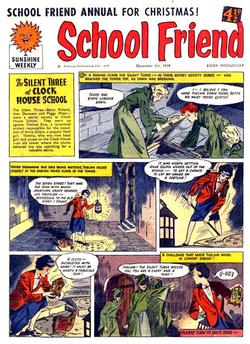The Amalgamated Press (AP) was a British newspaper and magazine publishing company founded by journalist and entrepreneur Alfred Harmsworth (1865–1922) in 1901, gathering his many publishing ventures together under one banner. At one point the largest publishing company in the world, AP employed writers such as Arthur Mee, John Alexander Hammerton, Edwy Searles Brooks, and Charles Hamilton. Its subsidiary, the Educational Book Company, published The Harmsworth Self-Educator, The Children's Encyclopædia, and Harmsworth's Universal Encyclopaedia. The company's newspapers included the Daily Mail, the Daily Mirror, The Evening News, The Observer, and The Times. At its height, AP published over 70 magazines and operated three large printing works and paper mills in South London.
A story paper is a periodical publication similar to a literary magazine, but featuring illustrations and text stories, and aimed towards children and teenagers. Also known in Britain as "boys' weeklies", story papers were phenomenally popular before the outbreak of the Second World War.

Valiant was a weekly British comics periodical published by Fleetway Publications and later IPC Magazines from 4 October 1962 to 16 October 1976. A boys' adventure comic, it debuted numerous memorable characters, including Captain Hurricane, The Steel Claw and Mytek the Mighty. Valiant lasted for 712 issues before being merged with stablemate Battle Picture Weekly.

The Comet was a weekly British comics periodical published by J.B. Allen and later Amalgamated Press and Fleetway Publications from 20 September 1946 to 17 October 1959. Initially a children's newspaper, The Comet was transformed into a boys' adventure comic in May 1949 by editor Edward Holmes when J.B. Allen were purchased by Amalgamated Press. Also known as Comet Comic, The Comet Adventure Weekly, Comet Weekly and simply Comet as various points the title continued until October 1959, reaching 580 issues before being merged with another AP boys' comic, Tiger.
Elizabeth Gertrude Bunter, better known as Bessie Bunter, is a fictional character created by Charles Hamilton, who also created her more famous brother Billy Bunter.

Charles Henry Chapman (1879–1972), who signed his work as C. H. Chapman, was a British illustrator and cartoonist best known for his work in boys' story papers such as The Magnet where the character Billy Bunter appeared. He later illustrated Bunter cartoon strips and several Bunter books published in the 1950s and 1960s.
Leonard James Matthews was a British editor, publisher, writer and illustrator of comics and children's magazines, best known as the founder of the educational magazine Look and Learn.
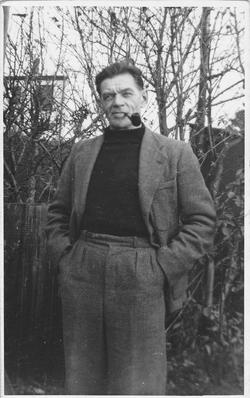
Frank John Minnitt was a British illustrator and cartoonist who drew for over 100 comic papers from the 1920s to the 1950s. He is perhaps best known for his depictions of Billy Bunter in the comic Knockout between 1939 and 1958.

Princess Tina was a British weekly girls' comic anthology published by Fleetway Publications and IPC Magazines from 23 September 1967 to 12 January 1974. The comic was created by combining two underperforming Fleetway titles — Princess and Tina — into a third, new comic. Notable strips included the long-running family drama "The Happy Days" and "Patty's World". The latter would outlive Princess Tina, continuing after the comic was merged into Pink.

Knockout was a weekly British comics periodical published by Amalgamated Press and later Fleetway Publications and IPC Magazines from 4 March 1939 to 16 February 1963. A boys' adventure comic, the title ran for 1227 issues before being merged with Valiant.
British girls' comics flourished in the United Kingdom from the 1950s through the 1970s, before beginning to decline in popularity in the 1980s and 1990s. Publishers known for their girls' comics included DC Thomson and Fleetway/IPC. Most titles appeared weekly, with the content primarily in picture-story format. The majority of the stories were serialized, with two or three pages per issue, over eight to twelve issues. They were marketed toward young teen girls.

Girls' Crystal was a British weekly fictional anthology publication aimed at girls. Published by Amalgamated Press and later Fleetway Publications from 26 October 1935 to 18 May 1963. Uniquely for an Amalgamated Press title, Girls' Crystal began as a story paper before transforming into a picture comic between editions, with the new format debuting on 21 March 1953. It ran for a combined total of 1432 issues before merging with School Friend in 1963.
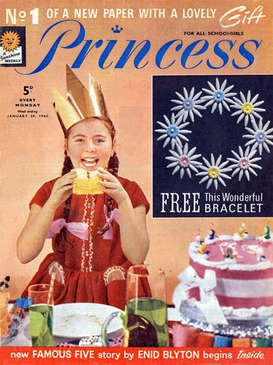
Princess was a British weekly girls' comic anthology published by Fleetway Publications and, later, IPC Magazines. The first version was published between 30 January 1960 and 16 September 1967, and featured a mix of comic strips, text stories and a large proportion of features; it was merged with Tina to form a new title - Princess Tina - after 399 issues.

June was a British weekly girls' comic anthology published by Fleetway Publications and IPC Magazines from 18 March 1961 to 15 June 1974. Designed as a response to DC Thomson's hit Bunty, June never quite eclipsed its Scottish rival but was nevertheless a success on its own terms, reaching 631 issues before being merged into Tammy in 1974.
Battler Britton is a British comics character created by Mike Butterworth and Geoff Campion. He first appeared in Amalgamated Press' Sun in 1956, and later featured in Knockout, and the long-running digest titles Thriller Picture Library, Air Ace Picture Library, and War Picture Library.
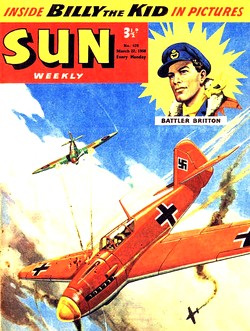
Sun was a weekly British comics periodical published by J. B. Allen, Amalgamated Press and Fleetway Publications between 11 November 1947 and 17 October 1959. During this time it was also known as Sun Comic, Sun Adventure Weekly, The Cowboy Sun Weekly, The Cowboy Sun, The Sun and Sun Weekly at various points, and ran for 551 issues before merging with Lion.
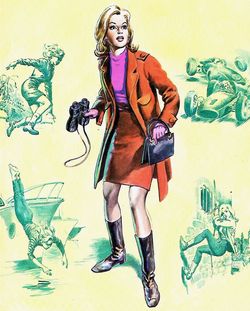
Jane Bond is a British comic character who has appeared in the strip "Jane Bond - Secret Agent", published by Fleetway Publications and IPC Magazines. The character, a globetrotting secret agent, first appeared in the girls' anthology title Tina on 25 February 1967, drawn by Mike Hubbard. After Tina was cancelled "Jane Bond - Secret Agent" continued in the merged Princess Tina until 1970.
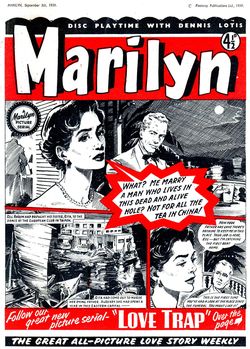
Marilyn was a British girls romance comic published weekly by Amalgamated Press and Fleetway Publications between 19 March 1955 and 18 November 1965. It ran for between 547 and 549 issues before merging with Valentine.

Poppet was a British weekly girls' comic anthology published by Fleetway Publications from 5 October 1963 to 11 July 1964. The title was short-lived, running for 41 issues before being merged into June.
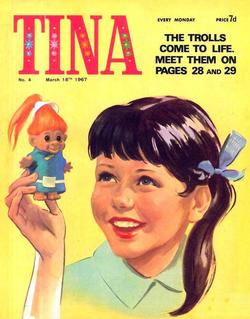
Tina was a British weekly girls' comic anthology published by Fleetway Publications from 25 February to 16 September 1967. The title was created specifically to be syndicated by a consortium of European publishers, and was particularly successful in the Netherlands. However, it struggled to make a mark in the British domestic market, and after 40 issues was merged with Princess to create successor title Princess Tina.
